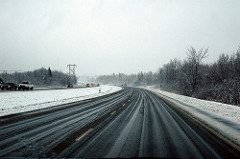Once upon a time, many years ago when I lived on Vancouver Island, my vehicle broke down. It was about 10 p.m. and I was on my way back from a weekend in Vancouver with family and friends. I had to leave it on the side of the highway and walk about a kilometre into town as the snow fell.
It was the 1990s, before cellphones were common, and I didn’t really know anyone except for my coworkers at the newspaper, since I had just moved there for my job as a reporter.
It was a bit scary, alone in the dark, but at least I had a big strong dog with me. In fact, from the dog’s perspective, it was pretty exciting to go for a walk, especially in the snow, which (as a part husky) he absolutely loved. I put him on his leash and started off, only to realize my shoes were totally inadequate for the slippery terrain.
As the dog trotted along happily, he pulled me off-balance and I slipped on the ground and fell – again and again – struggling along with my camera bag and backpack. At one point I was even crying, wishing I could just phone my dad to come and pick me up!
Luckily I wasn’t injured – aside from a lot of leg bruises – and I made it to town and phoned my employer, who was kind enough to give me a ride home. Too bad I hadn’t asked myself this important question: “Are you prepared to be stranded on the side of the road?”
In his recent blog post Do You Have Fifteen Seconds to Prepare an Emergency Kit? occupational health and safety advisor Jimmy Sandhu reminds us why this question is so important.
Public Safety Canada recommends you keep the following items in your car in case of the unexpected:
* Food that won’t spoil, such as energy bars
* Water – plastic bottles that won’t break if the water freezes (replace them every six months)
* Blanket
* Extra clothing and shoes or boots
* First aid kit with seatbelt cutter
* Small shovel, scraper and snowbrush
* Candle in a deep can and matches
* Wind‑up flashlight
* Whistle – in case you need to attract attention
* Roadmaps
* Copy of your emergency plan
Please keep this in mind during your travels in the cold. For much more information on driving in the cold, check out Shift Into Winter.



